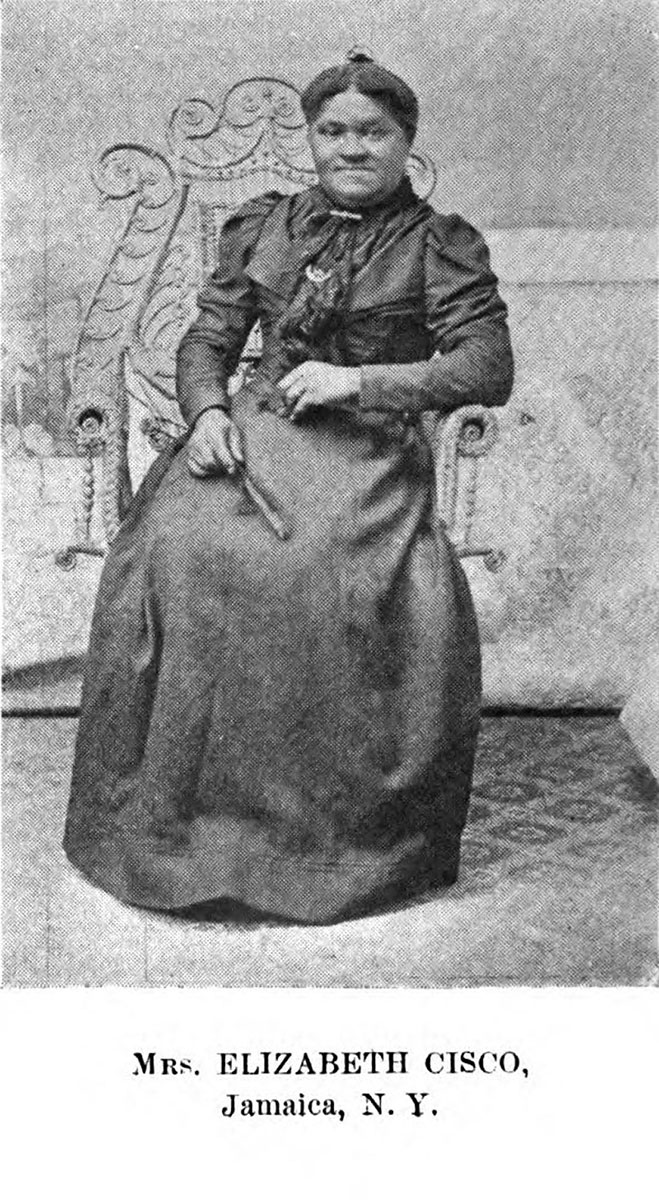You are here:
Mrs. Elizabeth Cisco

Date: undated
Caption: Mrs. Elizabeth Cisco lived in Jamaica, Queens, with her children and, until he passed away in 1897, her husband Samuel Cisco. She sat for this formal studio portrait at some point, although we do not know exactly what year, or whether it was before or after she and her husband began to challenge school segregation in 1896, or before or after she sued the Queens school board in 1899.

Photography has an important place in African American history. When racist practices and beliefs denied Black people’s dignity and humanity, Black individuals and families with the means to do so could go to a photography studio and present themselves as they wanted the world to see them. Frederick Douglass, the famous abolitionist and writer who had been born into slavery, used photography to spread the powerful image of himself that he wanted the world to see and recognize. Douglass made himself the most photographed person in the US in the 19th century, in a time when cameras were large, cumbersome, and expensive, and could be accessed only by going to a photography studio.1
Sojourner Truth also represented herself via photography. She printed “cartes de visite,” or printed and illustrated cards, with her image on them. She sold these to help fund her work— - a point that she made in the caption of the cards themselves, which read “I Sell the Shadow to Support the Substance.” Truth made decisions, as well, about what clothing and what other objects would appear in her photographs.2
The portrait above is of Mrs. Elizabeth Cisco, who was an African American woman living in Jamaica, Queens in the 1890s, before it became part of New York City. Cisco and her husband— - and then Cisco alone, after his passing— - used multiple strategies to try to secure a quality education for their children and to challenge school segregation.
Why did Mrs. Elizabeth Cisco choose to have this photograph made when she did? What were her ambitions in having the photograph made? Although we do not know the answers to these questions, we can ask about how this photograph might connect to the longer tradition of Black photography as an act of self-representation, including as a protest against other demeaning or racist depictions of Black people at the time.
-
Deborah Willis, introduction to Picturing Us: African American Identity in Photography (New York: New Press, 1996). ↩︎
-
Augusta Rohrbach, “Shadow and Substance: Sojourner Truth in Black and White,” in Pictures and Progress: Early Photography and the Making of African American Identity, ed. Maurice O. Wallace and Shawn Michelle Smith (Durham, NC: Duke University Press, 2012), 83. ↩︎
Categories: Queens, parent activism, K-12 organizing
Tags: racist segregation, court cases, Black people, school facilities, photography, imagery, and visual representation, women's activism, legislation
This item is part of "Elizabeth Cisco Resisting Segregation in Queens" in "Black and Latina Women’s Educational Activism"
Item Details
Date: undated
Source: William Henry Johnson, The Autobiography of Dr. William Henry Johnson (Albany, NY: The Argus Company, 1900).
Copyright: Public domain
How to cite: “Mrs. Elizabeth Cisco,” in New York City Civil Rights History Project, Accessed: [Month Day, Year], https://nyccivilrightshistory.org/gallery/elizabeth-cisco.
Questions to Consider
- What message do you think Mrs. Cisco wanted to send through this picture? What choices do you think she made that helped send that message?
- Do you use photography to represent yourself? What kinds of decisions do you make about how you appear in photographs, and why?
- How do you feel seeing a portrait of a Black woman who helped make segregation illegal in New York schools?
- Historian Evelyn Brooks Higginbotham writes about the “politics of respectability.” She uses that term to argue that Black women of Cisco’s generation were contesting white supremacy while also insisting that Black people conformed “to the dominant society’s norms of manners and morals.” Do you think that this portrait of Mrs. Cisco reflects “the politics of respectability”? Why might have activist women like Mrs. Cisco chosen to present themselves as “respectable”?
- Another Black woman activist in New York at the time - Elizabeth Jennings - was also photographed. What similarities or differences do you see between her portrait and that of Mrs. Cisco?
References
How to Print this Page
- Press Ctrl + P or Cmd + P to open the print dialogue window.
- Under settings, choose "display headers and footers" if you want to print page numbers and the web address.
- Embedded PDF files will not print as part of the page. For best printing results, download the PDF and print from Adobe Reader or Preview.
